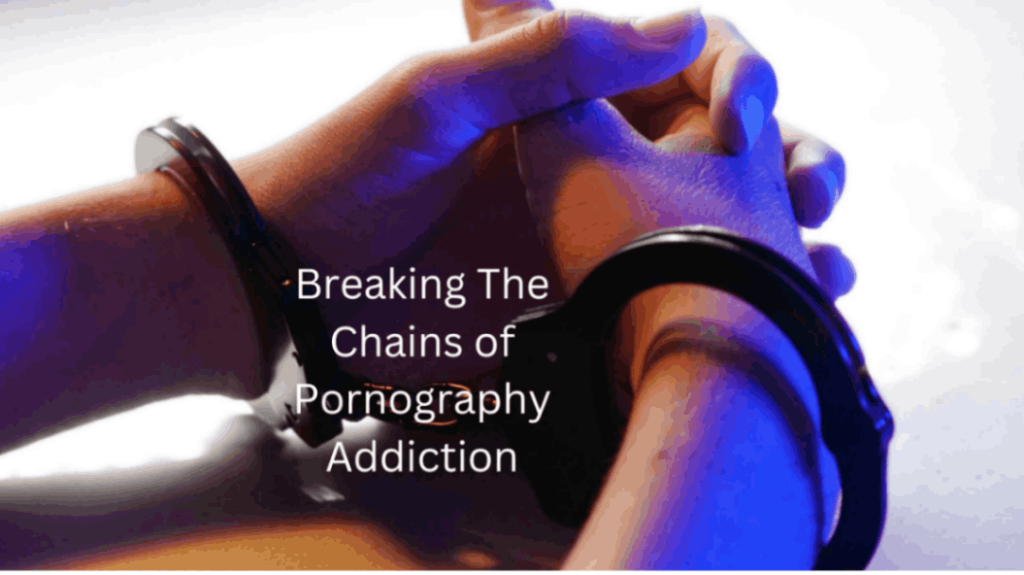I. Introduction
Pornography addiction refers to a pattern of excessive, compulsive, and uncontrollable consumption of explicit sexual material to the point where it has a negative impact on an individual’s life. It is similar to other forms of behavioral addictions, such as pathological gambling and internet use disorder. Individuals who struggle with pornography addiction often find it difficult to control their urges and may continue the behavior despite negative consequences.

In recent decades, the widespread availability and accessibility of online pornography have led to concerns about its potential impact on individuals and society. Pornography addiction has gained significant attention due to its prevalence and potential adverse effects on mental, emotional, and relational well-being.
Determining the exact prevalence of pornography addiction is challenging due to the private and stigmatized nature of the issue. However, numerous studies have indicated that a substantial number of individuals struggle with compulsive pornography use. Research suggests that between 1% and 10% of the general population may meet the criteria for pornography addiction, with higher rates among adolescents and young adults.
II. Understanding pornography addiction
A. Brain Chemistry and Neural Pathways:
At the heart of addiction lies the intricate interplay of brain chemistry and neural pathways. Consuming pornography, like engaging in other rewarding activities, triggers the release of dopamine, a neurotransmitter associated with pleasure and reward. Repeated exposure can lead to the reinforcement of neural pathways, creating a cycle where the brain craves the pleasurable experience associated with pornography. Over time, this can result in individuals seeking more explicit or novel content to maintain the same level of satisfaction.
B. Neuroplasticity and the Potential for Change:
The brain’s remarkable ability to adapt, known as neuroplasticity, plays a crucial role in addiction. While repeated exposure to explicit content can lead to the development of addictive patterns, neuroplasticity also offers hope for change. With appropriate interventions and support, individuals can rewire their neural pathways, gradually reducing the strength of associations between pornography and pleasure. This highlights the potential for recovery and underscores the importance of seeking help when grappling with pornography addiction.
III. Dispelling Stigma and Self-Blame
A. Addiction as a Medical Condition:
It is essential to recognize that addiction, including pornography addiction, is a mental health problem rather than a mere lack of willpower or moral failing. Just as substance use disorders are acknowledged as mental health problem, pornography addiction should also be treated with a similar understanding. Just like other behavioral addictions, such as pathological gambling, the brain’s response to certain stimuli contributes to the development and persistence of addictive behaviors.
B. Addressing Misconceptions and Biases:
Stigma and misconceptions often surround discussions about pornography addiction, making it difficult for individuals to seek help or openly address their struggles. One common misconception is that addiction is a choice, leading to self-blame and a sense of guilt. However, the neurological changes that occur in the brain as a result of addiction indicate that it is far more complex than a simple decision. By fostering open and empathetic conversations, we can work to reduce stigma and create an environment where individuals feel comfortable seeking help.
IV. Seeking Help and Support in pornography addiction
Addressing pornography addiction is a courageous journey that often requires reaching out for help and support. While overcoming addiction can be challenging, seeking assistance is a crucial step toward recovery.
A. The Role of Professional Assistance
Professional help is a cornerstone of addiction recovery. Psychiatrists, clinical psychologists, and other mental health professionals are trained to provide guidance, understanding, and evidence-based interventions tailored to an individual’s needs. These professionals create a safe space for individuals to discuss their struggles, triggers, and underlying issues that may contribute to pornography addiction. Collaborating with mental health professionals can offer invaluable insights and strategies to overcome pornography addiction.
B. Cognitive-Behavioral Therapy (CBT) and Other Therapeutic Approaches:
Cognitive-Behavioral Therapy (CBT) is a widely recognized therapeutic approach for treating addiction. In the context of pornography addiction, CBT helps individuals identify and challenge distorted thought patterns, manage triggers, and develop healthy coping mechanisms. Additionally, other therapeutic modalities, such as mindfulness-based therapy, dialectical behavior therapy (DBT), and group therapy, can also play a significant role in addressing the emotional and psychological aspects of addiction.
V. Building a Support Network to overcome pornography addiction
A. Family, Friends, and Loved Ones:
Support from loved ones can be a vital source of encouragement and motivation in the recovery process. Opening up to family members and friends about pornography addiction can be challenging due to stigma and shame. However, sharing one’s struggles with trusted individuals can foster understanding and lead to a stronger support system. Loved ones can offer emotional support, hold individuals accountable, and celebrate their progress.
B. Benefits of Support Groups and Communities:
Support groups and communities dedicated to pornography addiction recovery provide a sense of belonging and connection. Individuals can relate to others who have faced similar challenges, reducing feelings of isolation and shame. These groups offer a platform for sharing experiences, learning from others’ journeys, and receiving non-judgmental guidance. The collective wisdom and empathy within these communities can inspire hope and resilience.
VI. Coping Mechanisms and Emotional Triggers of pornography addiction
Understanding and addressing the emotional triggers that contribute to pornography addiction is a critical aspect of the recovery journey.
A. Identifying Emotional Triggers of relapse to pornography addiction
Stress, Anxiety, and Other Contributing Factors:
Emotional triggers are events, situations, or emotions that lead individuals to seek solace or escape through pornography consumption. Stress and anxiety are common triggers, as individuals may turn to explicit content as a way to temporarily alleviate emotional discomfort. Other contributing factors could include boredom, loneliness, low self-esteem, and unresolved trauma. Recognizing these triggers is essential for gaining insight into the root causes of pornography addiction.
Understanding the Link between Emotions and Pornography Addiction
Pornography addiction often forms as a means of self-medication to cope with challenging emotions. The brain’s response to addictive substances or behaviors, including pornography consumption, can provide temporary relief from emotional distress. Over time, this pattern becomes ingrained, and individuals may struggle to regulate their emotions without addictive behavior.
B. Developing Healthy Coping Strategies to overcome pornography addiction
Hobbies, Exercise, Creative Outlets:
Engaging in positive and fulfilling activities can serve as healthy alternatives to pornography consumption. Pursuing hobbies, such as playing a musical instrument, painting, writing, or engaging in sports, can divert attention away from triggers and provide a sense of accomplishment. Exercise is another effective coping mechanism, as physical activity releases endorphins, improving mood and reducing stress.
Mindfulness Techniques and Stress Management:
Mindfulness techniques, such as meditation, deep breathing, and progressive muscle relaxation, can help individuals manage stress and anxiety without resorting to addictive behaviors. Mindfulness encourages individuals to be present in the moment, observe their emotions without judgment, and develop greater self-awareness. Stress management strategies, such as time management and setting realistic goals, also play a pivotal role in preventing emotional triggers.
VII. Setting Goals and Celebrating Progress in recovery from pornography addiction
In the journey towards overcoming pornography addiction, setting goals and celebrating progress play a pivotal role in maintaining motivation, building resilience, and achieving lasting change.
A. The Importance of Setting Realistic Goals
Short-Term and Long-Term Objectives:
Setting both short-term and long-term goals is essential in the recovery process. Short-term goals provide immediate targets that contribute to the overall recovery journey. Long-term goals, on the other hand, serve as the overarching vision for where individuals want to be in the future. This combination of objectives creates a roadmap that offers direction and purpose.
Breaking Down the Recovery Journey into Manageable Steps:
The process of overcoming pornography addiction can feel daunting. Breaking down the journey into smaller, manageable steps not only makes the path seem more achievable but also helps prevent overwhelming feelings. These smaller goals provide opportunities for incremental progress and create a sense of accomplishment with each milestone reached.
B. Celebrating Small Victories
Recognizing Progress and Achievements:
Acknowledging even the smallest achievements is crucial in maintaining motivation and self-esteem. Every step forward, no matter how minor it may seem, is a victory that demonstrates growth and effort. Recognizing progress helps individuals maintain a positive perspective and reminds them that they are moving forward, even if progress is gradual.
Boosting Motivation and Fostering a Sense of Accomplishment:
Celebrating progress serves as a powerful motivator. The act of celebrating reinforces the idea that positive change is possible and encourages individuals to continue striving for improvement. Celebrating milestones, such as completing a week without engaging in addictive behavior or successfully managing a triggering situation, boosts confidence and fosters a sense of accomplishment.
VIII. Fostering Self-Compassion and Resilience in recovery from pornography addiction
The journey of pornography addiction recovery is often fraught with obstacles and uncertainties. Fostering self-compassion and resilience is not only essential for navigating these challenges but also pivotal in achieving lasting change.
A. Embracing Self-Compassion
Treating Oneself with Kindness and Understanding:
Self-compassion involves extending the same kindness and understanding to oneself as one would to a close friend. Individuals struggling with pornography addiction often grapple with feelings of shame, guilt, and self-blame. Embracing self-compassion means acknowledging that everyone faces challenges and setbacks, and treating oneself with the same understanding and empathy as one would offer to others.
Countering Negative Self-Talk and Shame:
Negative self-talk can be a powerful barrier to recovery. Individuals may berate themselves for relapses or perceived failures, perpetuating a cycle of shame and discouragement. Practicing self-compassion involves challenging and transforming negative self-talk into self-affirming and supportive messages. By reframing these thoughts, individuals can cultivate a more nurturing and constructive inner dialogue.
B. Viewing Setbacks as Opportunities
Learning from Relapses and Challenges:
Rather than viewing relapses or setbacks as insurmountable failures, individuals can approach them as opportunities for growth and learning. Each setback offers insights into triggers, vulnerabilities, and areas that require additional support or strategies. This approach shifts the focus from self-blame to self-awareness, enabling individuals to make informed choices moving forward.
Using Setbacks to Refine Strategies and Approaches:
Resilience thrives when setbacks are utilized to refine and adapt recovery strategies. Individuals can analyze the circumstances leading to the setback, identify potential triggers, and adjust their coping mechanisms accordingly. This proactive approach empowers individuals to continuously improve their skills in managing cravings and triggers, enhancing their overall resilience.
IX. Embracing a Hopeful Future in the pathway to recovery
Amidst the challenges of pornography addiction recovery, there lies a beacon of hope—a hopeful future that awaits those who embark on the journey of healing and transformation.
A. Rediscovering Purpose and Meaning
Rebuilding Relationships and Connections:
One of the most rewarding aspects of pornography addiction recovery is the opportunity to mend and rebuild relationships that may have been strained or damaged. As individuals progress on their path to recovery, they can actively engage in repairing emotional bonds with loved ones. This process involves open communication, vulnerability, and a commitment to rebuilding trust. Rediscovering the joy of genuine connections can bring newfound purpose and meaning to life.
Cultivating a Renewed Sense of Self-Worth:
Addiction often erodes self-esteem and self-worth. Recovery provides a chance to restore a positive self-perception and cultivate a renewed sense of self. As individuals overcome challenges and setbacks, they gain a deeper understanding of their resilience and capacity for growth. This newfound self-worth becomes the foundation for pursuing goals, aspirations, and a more fulfilling life.
B. Moving Beyond Addiction
Building a Life Free from the Shackles of Pornography:
Recovery from pornography addiction is not just about abstaining from addictive behavior; it’s about creating a life that is rich with purpose, joy, and fulfillment. As individuals learn to manage triggers and cope with stress through healthy strategies, they gradually distance themselves from the grip of pornography addiction. This process empowers them to focus on their interests, passions, and long-term aspirations.
Embracing the Promise of Healing, Growth, and Transformation:
Recovery is a journey of profound transformation. As individuals overcome challenges and setbacks, they evolve into stronger, more resilient versions of themselves. This journey fosters personal growth, self-discovery, and a deeper understanding of one’s values. Embracing the promise of healing means acknowledging that while the road may be challenging, every step brings individuals closer to a brighter and more hopeful future.
X. Conclusion
Pornography addiction involves alterations in brain circuitry, triggers cravings, and can lead to detrimental effects on mental and emotional well-being. However, it is crucial to remember that addiction is not a sign of weakness, but rather a mental health problem that can be addressed through appropriate strategies and interventions.
Amid the darkness of addiction, a glimmer of hope shines through. Recovery from pornography addiction is not only possible but achievable with dedication, support, and the right tools.
Remember that healing is not linear; relapses may occur, but they do not define your journey. Each setback is a chance to learn, grow, and refine your approach. By maintaining a sense of hope, even in challenging moments, you can persevere and continue on the path of recovery.





